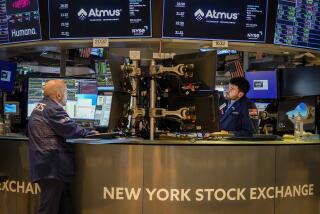Safe Parking Places When Road to Riches Is Rough
- Share via
Worried stock market investors have plenty of safer places to hide--and at much more attractive returns than a year ago, courtesy of the Federal Reserve’s campaign to raise interest rates.
Traditional cash parking places, from money market mutual funds to Treasury bills to short-term bond mutual funds, now offer investors annualized yields in the 5% to 6.5% range, and varying degrees of protection for their principal.
What’s the best option, if you’re looking to shelter some of your stock market gains or just preserve your cash for potential investment in stocks or other securities later on?
In large part, the best parking place will depend on how long you expect to keep the money on the sidelines--and how much higher you think market interest rates are likely to go.
Here’s a look at some of the most popular safe-havens:
Money Market Funds
“I think money funds are the clear superior choice right now, primarily because the chances of further [Fed] rate hikes is high,” says Peter Crane, managing editor of interest rate research firm Imoneynet.com.
When short-term rates are rising, money funds shine. That’s because the funds invest in short-term IOUs of major companies, the federal government or its agencies--that is, debt securities that mature, on average, in less than three months.
As market rates rise, newly issued short-term securities naturally yield more as well. Because money funds are rapidly turning over those securities as they mature, they’re earning more in a rising-rate environment--and passing through the higher yields to their investors.
The average maturity of securities in money funds is about 50 days now. As a result, “it takes just a month or a month-and-a-half for [a change in] interest rates to be reflected in money-market fund yields,” says Jay Mueller, an economist and portfolio manager with Strong Capital Management in Menomonee Falls, Wis.
Thus, in the wake of the Fed’s half-point boost in its key interest rate last week, expect money fund yields to rise nearly a half-point fairly shortly.
The average seven-day compound yield on taxable money funds now is 5.7%, and should break past 6% in coming weeks. That would be the highest they’ve paid in nine years.
The top-yielding taxable money funds are already yielding in the low-6% range: The seven-day compound yields for the Strong Investors Money Fund (phone: [800] 368-3863) and Vanguard Prime Money Market Fund ([800] 662-7447) are 6.42% and 6.20%, respectively.
Paul Westbrook, a financial planner in Ridgewood, N.J., notes that a key feature of money funds is that their share prices are designed to stay constant, at $1 a share--and you can get your cash out at any time, without penalty.
Tax-Free Money Market Funds
Regular taxable money funds invest in corporate and government IOUs. There also are tax-exempt money funds, which buy short-term IOUs issued by states and municipalities.
Though yields on tax-exempt money funds are lower than those on taxable funds, the case for tax-exempt funds may be more compelling if you’re in a high tax bracket, notes T. Rowe Price financial planner Christine Fahlund.
For instance, the average seven-day compound yield on tax-exempt money funds currently is 4.61%.
To find out if a tax-free fund makes sense for you, do the following calculation: Take your federal income tax rate and subtract it from 1. If you are in the 36% federal marginal income tax bracket, for example, subtract 0.36 from 1. Now, take the answer, 0.64, and divide that into the yield on a tax-free fund.
Dividing the average tax-free fund’s yield, 4.61%, by 0.64, we come up with 7.2. That means investors in the 36% bracket are getting a “taxable-equivalent” yield of 7.2%.
That’s above what taxable money funds are yielding, so it’s an attractive yield for high-income investors.
California-only tax-free money funds, meanwhile, pay yields that are exempt from both federal and state income taxes, for state residents.
But be careful: Tax-free money fund yields can be much more volatile than taxable fund yields, in part because of supply and demand for short-term municipal IOUs. You’ll have to monitor tax-free yields more closely to make sure you’re still getting a good deal.
CDs and T-Bills
As short-term rates have risen over the past year, CD rates and U.S. Treasury bill yields have shot up too. Today, the average 1-year CD is yielding 5.68%, according to Imoneynet.com.
A six-month T-bill offers an even higher yield: about 6.4% now. And note that T-bill interest is exempt from state income tax; CD interest isn’t.
You can find better-than-average CD yields by shopping around. For instance, several banks nationwide are offering 1-year CDs yielding 7% or more. Some 5-year CDs are yielding close to 8%.
On top of that, in a CD, your principal is federally insured.
But there are downsides to locking in your money in a CD. For starters, short-term rate hikes take a bit longer--about two months instead of one--to be reflected in new CD rates than money fund yields, Crane says.
Plus, if the Fed continues to raise its key rate, by locking in a CD or T-bill now you may be turning your back on higher yields to come.
Also, if circumstances suddenly change and the Fed stops raising rates, the stock market may rally. If you want to tap cash in a CD, the penalty for taking your money out before maturity can be high. (A T-bill, meanwhile, can be sold before maturity, but that will cost you a broker’s commission.)
So if you decide to park your money in a CD, you may want to stick with shorter-term CDs, which you can then reinvest at potentially higher rates upon maturity, experts say.
Ultra-Short-Term Bond Funds
“If you think interest rates will move up--and quickly--you want something that’s most responsive to those rising rates, which is a money market fund,” says Jim Sarni, a portfolio manager at Los Angeles-based money manager Payden & Rygel.
“On the other hand, if you think short-term rates have gone up as much as they can, and rates might stabilize, you might want to pick up a [little extra] yield,” he says.
That’s where an ultra-short-term bond fund may come into play. These funds, offered by such fund companies as Charles Schwab and Strong Funds, typically own corporate or government IOUs with average maturities of less than one year.
Annualized yields range from 5% to 6% now.
Still, comparing those yields with what money market funds pay, “You’re not getting that much extra yield to go out further on the [interest rate] curve,” Mueller says.
Unlike a money fund, an ultra-short bond fund’s share price isn’t constant. Though it may vary little, it can decline if market interest rates surge, devaluing the bonds in the portfolio.
The advantage of ultra-short funds is that their yields will hold up longer once rates peak.
One subset of the ultra-short bond fund universe that appears to be holding up as rates rise are so-called floating rate funds, which invest in senior secured bank loans that companies take out for a variety of purposes, including acquisitions.
Because these are floating rate loans, many of these funds sport significantly higher yields than money-market funds. Among them: Franklin Floating Rate (12-month average yield, 8.0%, [800] 342-5236); EV Classic Senior Floating-Rate (12-month average yield, 6.9%, [800] 225-6265), and AIM Floating Rate (12-month average yield, 7.3%, [800] 959-4246).
Be careful though. Credit risk can be a concern among floating rate funds, which tend to invest in many non-investment grade loans. Also, many of these funds allow only for quarterly redemptions.
Short-Term Bond Funds
With average maturities of two to four years for the securities they hold, short-term bond fund managers can’t reinvest money at higher rates as quickly as ultrashort-term managers. So their yields don’t rise as fast amid a general rate uptrend.
Since analysts think short-term rates haven’t peaked, few believe that short-term bond funds are the best place to park your money right now.
Consider what happened last year: The average “total return” on short-term government bond funds was 2.5%, according to Lipper Inc. Although yields earned were 5% or more, the share prices of the funds fell as rising market rates made their bonds worth less.
If you are thinking about a short-term fund, though, stick with funds with shorter-than-average “durations,” which is a measure of interest rate sensitivity. Also consider the fund’s overall credit quality, experts say. To deliver higher-than-average payouts, a short-term bond fund may have to invest in non-investment grade bonds.
A handful of short-term funds are currently yielding more than the category average of 5.8%, while also sporting a shorter-than-average duration and higher-than-average credit quality. They include: Pimco Real Return Bond (12-month yield: 6.9%; [888] 877-4626); USAA Short-Term Bond (12-month yield: 6.3%; [800] 382-8722), and Harbor Short Duration (12-month yield: 5.9%; [800] 422-1050).
*
Paul J. Lim is a senior editor at U.S. News & World Report and a former Times staff writer. He can be reached at plim@usnews.com.
(BEGIN TEXT OF INFOBOX / INFOGRAPHIC)
Playing It Safe
Here’s a look at recent annualized yields on some favorite short-term “parking spaces” for investors’ cash:
Tax-exempt money market funds: 4.61%*
Taxable money market funds: 5.70
3-month U. S. Treasury bill: 5.98
6-month U.S. Treasury bill: 6.41
6-month savings certificate: 5.26
Ultra-short-term bond funds: 5.21**
Short-term U.S. government bond funds: 5.35**
Short-term investment-grade bond funds: 5.75**
*Interest is exempt from income taxes, so true return is higher.
** Average yield for 12 months ended April 30.
Sources: Imoneynet.com, Lipper Inc.
(BEGIN TEXT OF INFOBOX / INFOGRAPHIC)
The Fed’s Effect on T-Bills
The Federal Reserve has boosted its benchmark short-term interest rate six times since June, including last week’s half-point increase, to 6.5%. As the Fed has pushed its rate up, most other short-term interest rates have followed, though to varying degrees. Here is the yield on the six-month U.S. Treasury bill, monthly closes and latest:
Monday: 6.41%
Source: Bloomberg News
(BEGIN TEXT OF INFOBOX / INFOGRAPHIC)
Stay Short, or Go Long?
If you’re looking to earn a decent return on your savings in the long run, history suggests that “parking places” such as money market mutual funds aren’t the place to be. Measured through 1999, you would have earned higher “total” returns--interest earned plus or minus change in principal value--in longer-term bond funds over the previous 10 years. But when market interest rates are rising, as they have been for the last year, shorter-term accounts always fare better. A sampling of average annualized total returns for key income-fund categories:
*--*
Average annualized total returns, through 1999: Income-fund category 1 year 3 years Money market 4.49% 4.78% Ultra-short-term 4.58 5.24 Short-term 2.50 4.61 government Short-term 2.80 4.92 investment-grade Intermediate-term --1.68 4.59 government Intermediate-term --1.31 4.82 investment-grade Long-term government --3.02 4.51 Long-term --2.61 4.58 investment-grade Junk corporate 4.53 5.18
Income-fund category 10 years Money market 4.80% Ultra-short-term 5.59 Short-term 5.66 government Short-term 6.36 investment-grade Intermediate-term 6.44 government Intermediate-term 7.09 investment-grade Long-term government 6.63 Long-term 7.30 investment-grade Junk corporate 10.03
*--*
Source: Lipper Inc.
More to Read
Inside the business of entertainment
The Wide Shot brings you news, analysis and insights on everything from streaming wars to production — and what it all means for the future.
You may occasionally receive promotional content from the Los Angeles Times.










